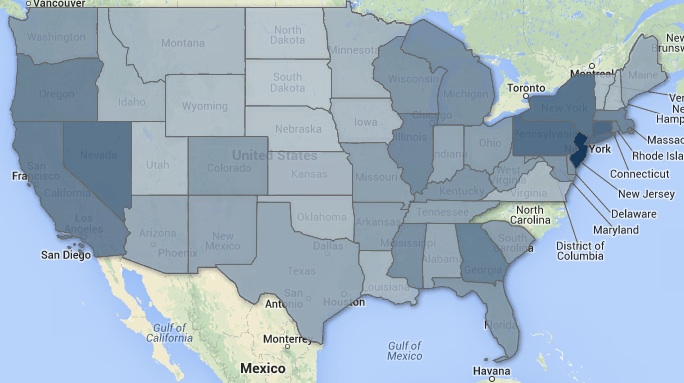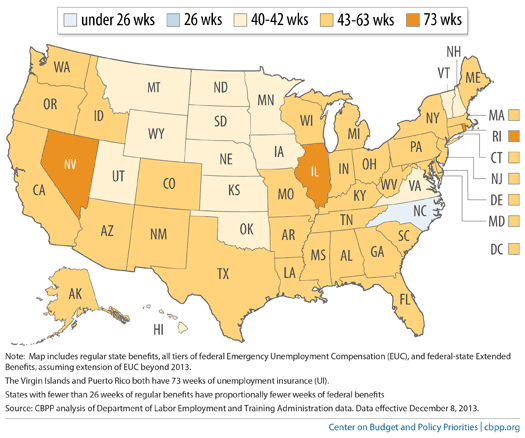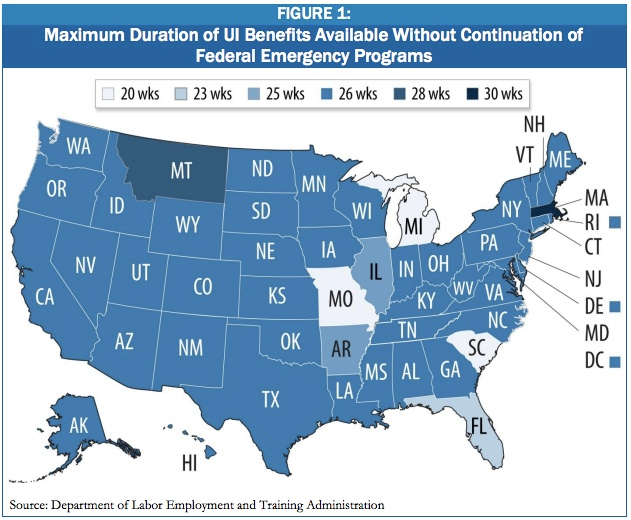
Darker shading corresponds to states where a higher share of the population is affected.
Congress offered the extended benefits as unemployment ballooned during the Great Recession and has put off their expiration 11 times since. Renewing the long-term insurance is a top agenda item for the Senate when it convenes Jan. 6, Sen. Majority Leader Harry Reid (D-Nev.) has said. The body is expected to vote quickly on a three-month extension of the benefits.
Recipients still face, at best, a delay in their checks and, at worst, a permanent end to them. When the aid expires Saturday, the unemployed will only be able to collect a maximum 26 weeks of benefits in most parts of the U.S., down from about twice as much in many states.
The recession may technically be over, but for many the recovery has yet to begin. The plight of the long-term unemployed - a group the benefits are aimed at helping and whose ranks have swelled - has also proven particularly difficult to solve. Studies have shown that they are more likely to suffer mental-health setbacks and are less likely to be hired.
And every state but one - North Dakota - has added more people than jobs since the recession began. Nationally, that deficit between jobs and population growth equates to roughly 9.2 million jobs, according to the Economic Policy Institute, a think tank that produces research focused on low- and middle-income workers. In 33 states, the gap between jobs and population growth is 5 percent or greater.
Some 1.3 million people are expected to lose benefits when they expire Saturday, with more to come depending on whether or not Congress extends the emergency unemployment insurance. Those affected are spread across the country, with California home to just under 215,000 and New York home to more than 125,000 (see map below), according to Labor Department data compiled by Democrats on the House Committee on Ways and Means.
But, as a share of its population, New Jersey will take the biggest immediate hit. On Saturday, some 90,000 people there will lose benefits, or roughly 1 percent of the state's population. North Dakota and South Dakota will see the smallest proportional effect, with less than 0.05 percent of the population affected.
Where the people losing benefits live, by state
Darker shading corresponds to counties where a higher share of the population is affected.
A full-screen map is available here.
Where they live, by county
The Ways and Means Democrats also compiled data from agencies and organizations on who's affected at the county level in 17 states (where the data was available). We were able to map most of that data below (excluding one of the states and for all but a handful of counties). Here's a non-comprehensive county-level look at who's affected (click and drag to see more):
Darker shading corresponds to counties where a higher share of the population is affected.
A full screen version is available here.
Benefits by state before the Saturday expiration
Because eligibility and benefits are determined at the state level, unemployment benefits vary across the nation. Here's how that patchwork looks today, according to the Center on Budget and Policy Priorities, a think tank focused on policies affecting those of low and moderate incomes.
Benefits by state after Saturday's expiration
Here's what it will look like after:
Niraj Chokshireports for GovBeat, The Post's state and local policy blog. Before that he had covered economic, budget, tax and transportation policy for National Journal, blogged at The Atlantic and reported on the business of the nation's largest law firms in California for The Recorder.





Reader Comments
to our Newsletter